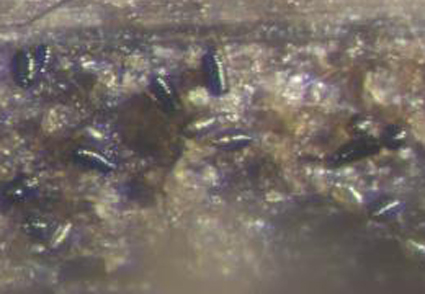Abstract
Pseudohelicoon ellipsoideum sp. nov. from a decaying rachis of an unidentified palm submerged in a freshwater stream at Linmei-Shipan Trail, Taiwan, is described and illustrated. The phylogeny of Pseudohelicoon and other Helicoon species (sensu lato) was inferred by a concatenated dataset of the ITS and partial LSU segments of the nuc rDNA. The new species is phylogenetically positioned among the other two previously described species of Pseudohelicoon, but morphologically it differs from them in the shape and size of conidia.
References
- Baral, H.O., Weber, E., Gams, W., Hagedorn, G., Liu, B., Liu, X., Marson, G., Marvanová, L., Marc Stadler, M. & Weiß, M. (2018) Generic names in the Orbiliaceae (Orbiliomycetes) and recommendations on which names should be protected or suppressed. Mycological Progress 17: 5–31. https://doi.org/10.1007/s11557-017-1300-6
- Dayarathne, M.C., Maharachchikumbura, S.S.N., Jones, E.B.G, Dong, W., Devadatha, B., Yang, J., Ekanayaka, A.H., de Silva, W., Sarma, V.V., Al-Sadi, A.M., Khongphinitbunjong, K., Hyde, K.D. & Zhao, R.L. (2019) Phylogenetic revision of Savoryellaceae and evidence for its ranking as a subclass. Frontiers in Microbiology 10: 840. https://doi.org/10.3389/fmicb.2019.00840
- Edgar, R.C. (2004) MUSCLE: multiple sequence alignment with high accuracy and high throughput. Nucleic Acids Research 32: 1792–1797. https://doi.org/10.1093/nar/gkh340
- Fallah, P.M., Crane, J.L & Shearer, C.A. (1999) Freshwater ascomycetes: two new species of Ascotaiwania from North America. Canadian Journal of Botany 77: 87–92. https://doi.org/10.1139/b98-202
- Glen-Bott, J. (1955) Helicodendron tubulosum and some similar species. Transaction of the British Mycological Society 38: 17–30. https://doi.org/10.1016/S0007-1536(55)80003-4
- Goh, T.K. (1999) Single-spore isolation using a hand-made glass needle. Fungal Diversity 2: 47–63.
- Goh, T.K. & Hyde, K.D. (1996a) Biodiversity of freshwater fungi. Journal of Industrial Microbiology 17: 328–345. https://doi.org/10.1007/BF01574764
- Goh, T.K. & Hyde, K.D. (1996b) Helicoon gigantisporum sp. nov. and an amended key to the genus. Mycological Research 100: 1485–1488. https://doi.org/10.1016/s0953-7562(96)80083-9
- Goh, T.K. & Kuo, C.H. (2018) A new species of Helicoon from Taiwan. Phytotaxa 346: 141–156. https://doi.org/10.11646/phytotaxa.346.2.2
- Hernandez-Restrepo, M., Gené, J., Castañeda-Ruiz, R.F., Mena-Portales, J., Crous, P.W. & Guarro, J. (2017) Phylogeny of saprobic microfungi from Southern Europe. Studies in Mycology 86: 53–97. https://doi.org/10.1016/j.simyco.2017.05.002
- Index Fungorum (2024) Available from: http://www.indexfungorum.org/names/Names.asp (Accessed: 6 February 2024).
- Jayasiri, S.C., Hyde, K.D., Jones, E.B.G., McKenzie, E.H.C., Jeewon, R., Phillips, A.J.L., Bhat, D.J., Wanasinghe, D.N., Liu, J.K., Lu, Y.Z., Kang, J.C., Xu, J.1. & Karunarathna, S.C. (2019) Diversity, morphology and molecular phylogeny of Dothideomycetes on decaying wild seed pods and fruits. Mycosphere 10: 1–186. https://doi.org/10.5943/mycosphere/10/1/1
- Kumar, S., Stecher, G. & Tamura, K. (2016) MEGA7: Molecular Evolutionary Genetics Analysis version 7.0 for bigger datasets. Molecular Biology and Evolution 33: 1870–1874. https://doi.org/10.1093/molbev/msw054
- Lu, Y.Z., Liu, J.K., Hyde, K.D., Jeewon, R., Kang, J.C., Fan, C., Boonmee, S., Bhat, D.J., Luo, Z.L., Lin, C.G. & Eungwanichayapant, P.D. (2018) A taxonomic reassessment of Tubeufiales based on multi-locus phylogeny and morphology. Fungal Diversity 92: 131–344. https://doi.org/10.1007/s13225-018-0411-y
- Morgan, A.P. (1892) North American Helicosporae. Cincinnati Society of Natural History Journal 15: 39–52.
- Pfister, D.H. (1995) Helicoon sessile, the anamorph of Orbilia luteorubella. Inoculum 46: 34.
- Réblová, M., Seifert, K.A., Fournier, J. & Štěpánek, V. (2016) Newly recognised lineages of perithecial ascomycetes: the new orders Conioscyphales and Pleurotheciales. Persoonia 37: 57–81. https://doi.org/10.3767/003158516X689819
- Ronquist, F. & Huelsenbeck, J.P. (2003) MrBayes 3: Bayesian phylogenetic inference under mixed models. Bioinformatics 19: 1572–1574. https://doi.org/10.1093/bioinformatics/btg180
- Saitou, N. & Nei, M. (1987) The neighbor-joining method: A new method for reconstructing phylogenetic trees. Molecular Biology and Evolution 4: 406–425. https://doi.org/10.1093/oxfordjournals.molbev.a040454
- Sambrook, J. & Russell, D.W. (2001) Molecular cloning: a laboratory manual. Cold Spring Harbor Laboratory Press, Cold Spring Harbor, New York, 2344 pp.
- Stadler, M., Lambert, C., Wibberg, D., Kalinowski, J., Cox, R.J., Kolařík, M. & Kuhnert, E. (2020) Intragenomic polymorphisms in the ITS region of high-quality genomes of the Hypoxylaceae (Xylariales, Ascomycota). Mycological Progress 19: 235–245. https://doi.org/10.1007/s11557-019-01552-9
- Stamatakis A (2014) RAxML version 8: a tool for phylogenetic analysis and post-analysis of large phylogenies. Bioinformatics 30: 1312–1313. https://doi.org/10.1093/bioinformatics/btu033
- Tsui, C.K.M. & Berbee, M.L. (2006) Phylogenetic relationships and convergence of helicosporous fungi inferred from ribosomal DNA sequences. Molecular Phylogenetics and Evolution 39: 587–597. https://doi.org/10.1016/j.ympev.2006.01.025
- Vilgalys, R. & Hester, M. (1990) Rapid genetic identification and mapping of enzymatically amplified ribosomal DNA from several Cryptococcus species. Journal of Bacteriology 172: 4238–4246. https://doi.org/10.1128/jb.172.8.4238-4246.1990
- White, T.J., Bruns, T., Lee, S. & Taylor, J. (1990) Amplification and direct sequencing of fungal ribosomal RNA genes for phylogenetics. In: Innis, M.A., Gelfand, D.H., Sninsky, J.J. & White, T.J. (Eds.) PCR protocols: a guide to methods and applications. Academic Press, New York, pp. 315–322. https://doi.org/10.1016/B978-0-12-372180-8.50042-1
- Zimmermann, J., Voss, H., Schwager, C., Stegemann, J. & Ansorge, W. (1988) Automated Sanger dideoxy sequencing reaction protocol. FEBS Letters 233: 432–436. https://doi.org/10.1016/0014-5793(88)80477-0


